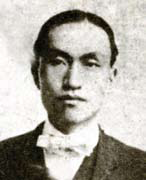In 1903, in San Francisco, Ahn Chang-ho and Lee Dae-wi organized the first Korean association in the Americas, known as the Friendship Society, with the aim of mutual assistance and improving the living conditions of the Korean community. In 1905, when Japan forcibly signed the Eulsa Treaty with Korea, he, along with others, established the Daedong Education Association in Pasadena, California, with the goals of training overseas students, publishing books, and issuing newspapers, and he was appointed as the secretary-general.
In March 1907, he, along with Baek Il-kyu and Moon Yang-mok, reorganized the Daedong Education Association into the Daedong Patriotic Society in San Francisco, where he became the central secretary-general. In July of that year, he urged the Korean community to rise up against the injustice of the Japan-Korea Treaty of 1907, which had been forcibly signed by Japan. In November of the same year, he organized a local branch in Shanghai and strengthened relations with China. He also founded the Daedong Gongbo, a publication that advocated for national spirit and the movement for the restoration of national rights.
In 1995, the government awarded him the Order of Merit for National Foundation.
Jang Gyeong-eun was a merchant selling ginseng in San Francisco. In September 1903, he co-founded the Korean Friendship Society in San Francisco with Ahn Chang-ho. This society was the first Korean organization established in the Americas, aimed at fostering communication and friendship among Koreans and promoting the improvement of living conditions in the Korean community.
In November 1905, when Japan signed the Eulsa Treaty and seized the sovereignty of the Korean Empire, he, along with An Jung-soo and Bang Sa-gyeom, organized the Daedong Education Association in Pasadena, California, in December of that year, with the purpose of training overseas students, publishing books, and issuing newspapers. He led the Daedong Education Association, facilitating the study abroad of Koreans and engaging in enlightenment activities for Korean expatriates in the Americas, as well as job placement efforts.
In March 1907, he reorganized the Daedong Education Association into the Daedong Patriotic Society with Baek Il-kyu and Moon Yang-mok in San Francisco, where he was appointed as the central secretary-general. The Daedong Patriotic Society emphasized active support and loyalty to the Emperor of the Korean Empire and aimed to raise awareness among Koreans in America regarding the restoration of national rights, engaging in activities such as facilitating study abroad, publishing books, issuing newspapers, and job placement. Following the signing of the Japan-Korea Treaty of 1907 in July, which led to the forced disbandment of the Korean Empire’s military, Jang Gyeong-eun urged his compatriots to rise up against this injustice.
In September 1907, Jang Gyeong-eun moved to Shanghai, where he established the Shanghai Local Branch of the Daedong Patriotic Society in November. At that time, about 30 students had already arrived in Shanghai to train as military officers, but their plans had gone awry, leaving them stranded without a plan. Upon learning of their situation, Jang Gyeong-eun created a Daedong Patriotic Society hall for the students to stay in and also operated the Daedong School. Meanwhile, in San Francisco, in October 1907, the Daedong Patriotic Society launched its official publication, the Daedong Gongbo, to promote national spirit, establishing newspaper distribution points in 10 locations in the continental U.S., 3 in Hawaii, 22 in Korea, and 1 in China.
In February 1909, Jang Gyeong-eun published a Chinese-language magazine called Taedong Sinbo in Shanghai. However, he soon moved to the United States, resulting in only one issue being published. He also received support from the Chinese expatriate community associated with the Qing Dynasty. Subsequently, in February 1910, the Daedong Patriotic Society merged with the National Association to form the Korean National Association, and in 1911, Jang Gyeong-eun, along with Ahn Chang-ho and An Jung-geun, visited the Mil-san base in Northern Manchuria. Afterward, he engaged in the ginseng trade in Southeast Asia, including Shanghai and Singapore, until he passed away from an illness on January 21, 1918, while traveling in Singapore.

Leave a Reply